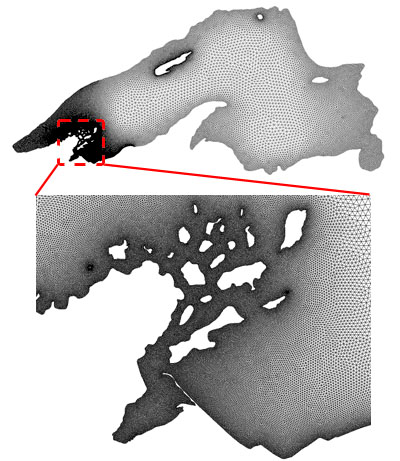About INFOS Apostles
INFOS Apostles is the product of a project funded by the Wisconsin Sea Grant program. The research and maintenance of this site is conducted by the Environmental Fluid Mechanics (EFM) group of the Civil Engineering Department at the University of Wisconsin-Madison. Many parties have acted to assist in the development of this site, including: Apostle Islands National Lakeshore, the City of Bayfield, and the Friends of the Apostle Islands. This page contains information about the methods used to produce the information presented at this site.
INFOS Apostles - MISSION
Our mission with this project is to combine and enhance information about the water environment of the Apostle Islands, Lake Superior. Currently, there are many great resources available via the internet; however, much of the information is scattered throughout the web, making it difficult for one to obtain a clear picture of the current conditions. We hope that the information presented will aid visitors in making safe decisions and act to enhance enjoyment of this beautiful place. We combine real-time observations from various sources, as well as, present nowcasting and forecasting guidance of waves, currents, water temperatue, and water levels in the Apostle Islands. Below is a schematic that highlights the main features of INFOS Apostles.

REAL-TIME OBSERVATIONS
INFOS Apostles pools observations from many sources in the local area. Meteorological data is combined from various weather stations including those maintained by the National Oceanic and Atmospheric Administration (NOAA). Direct wave measurements are limited in the Apostles, but a recent system has been developed for the Mainland Sea Caves and information from mid-lake, NOAA buoys are presented. In addition, links to real-time webcams show the current wave conditions of the nearshore. We do not provide means for downloading historic datasets of observed data.
NOWCAST & FORECAST - MODELS
The Great Lakes Environmental Research Laboratory (GLERL), of NOAA, currently provides Nowcasting and Forecasting model results for all of the Great Lakes. Due to the vast expanse of the Great Lakes, the GLERL models cannot resolve the relatively small effects caused by the 22 Apostle Islands. The models of INFOS Apostles devote a higher resolution to the Apostles (figure below) while maintaining the same meteorological forcing of the GLERL Great Lakes Models. There are currently two separate models used to simulate waves and circulation patterns in the Apostles.
WAVE MODEL - SWAN
Simulating Waves NearShore (SWAN) is a third generation wave model developed at Delft University in the Netherlands. It solves the conservation of wave action density to produce wave height, direction, and period. SWAN is particularly well-suited for nearshore applications, such as the Apostle Islands, where wave processes such as: refraction, diffraction, and breaking, play an important role. For more information about SWAN please visit the SWAN homepage.
CIRCULATION MODEL - FVCOMFinite Volume Coastal Ocean Model (FVCOM) is a three-dimensional, hydrostatic circulation model developed at the University of Dartmouth, MA. FVCOM's use of unstructured grids is ideally suited to resolve the complex shorelines of the Apostle Islands. With meteoroligical forcing, FVCOM calculated three-dimensional water velocities, as well as, water temperatures. For more information about FVCOM, please visit the FVCOM homepage .






